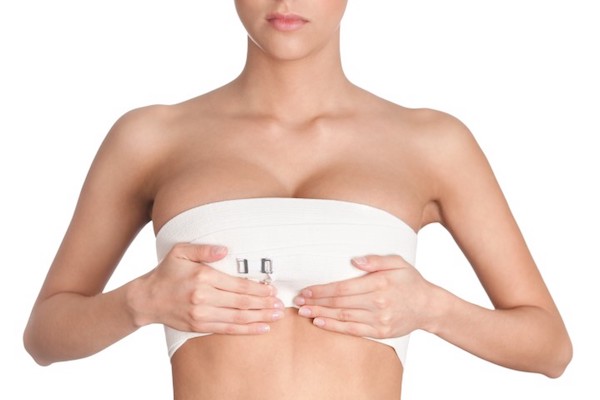Plastic Surgeon
Scottsdale

Conveniently located to serve the areas of Mesa, Tempe, Gilbert and Scottsdale, AZ

A breast reduction, or mammaplasty, is a surgery that removes glandular tissue, fat, and skin from oversized breasts to reduce their size and weight. Large breasts can cause pain, improper posture, rashes, breathing problems, skeletal deformities, and low self-esteem. Breast reduction surgery is usually done to provide relief from these symptoms. But it’s not just the size of the breasts that are reduced; this life-changing procedure also reduces the physical and emotional strain caused by large breasts.
If you’re interested in a breast reduction and an improved quality of life, Dr. Robert G. Bonillas can help. Call (480) 245-6380 to reach the helpful staff at Scottsdale Plastics and schedule your private consultation.
Contents
Performed under general anesthesia, breast reduction surgery removes fat and glandular tissue and tightens skin to produce smaller, lighter breasts that are balanced in proportion to the rest of the body. Through this process, not only is breast size decreased but the overall shape of the breasts is improved and the size and position of the nipple-areolar complex can be altered to better flatter your new breasts. Breast reductions are customized to each patient since every woman has unique needs and desires. During a personal consultation with Dr. Bonillas, your cosmetic goals will be discussed to ensure that your desired size is attained, and your concerns are addressed.
In some cases, it is necessary to perform a breast reduction with a breast lift. Such instances include strategic removal of excess skin, and tissue, as well as creating a new, higher location for the nipple-areolar complex, so that breasts are more proportionate, firmer, and lifted higher on the chest.
If you would like perkier, more petite breasts, contact Scottsdale Plastics in Arizona and our staff will be happy to assist you in scheduling a consultation.
While hundreds of thousands of women undergo breast augmentation each year on the quest for a more generous bustline, there are a significant number of women that decide to improve their lives by undergoing a breast reduction. In fact, the American Society of Plastic Surgeons reported that in 2020 alone, over 36,000 breast reductions were performed in the United States. Carrying the extra weight of oversized breasts causes significant stress on a woman’s body. As her body compensates for a displaced center of gravity, the spine is forced out of alignment, and strain is placed on the shoulder muscles. Apart from back and shoulder pain, this leads to pressure on nerves in the head, and also cause chronic headaches. [1] Breast reductions are often covered by insurance as a result. A breast reduction corrects these taxing symptoms, as well as:

Women with large, disproportionate breasts who experience pain, discomfort, and embarrassment due to their breast size may be good candidates for breast reduction surgery.
Although the procedure is generally recommended for mature women with fully developed breasts, breast reduction surgery can be performed on younger women if their breasts are causing serious pain and physical discomfort. In some instances, breast reduction surgery may be performed on a single breast if the patient has significant asymmetry.
Candidates for a breast reduction should not be pregnant or currently breastfeeding. Breast reduction surgery is not recommended for women who intend to breastfeed, since many of the milk ducts leading to the nipples are removed.
Your breast reduction consultation with Scottsdale’s top plastic surgeon Dr. Robert Bonillas will include a conversation about your aesthetic goals and the symptoms you’d like to remedy through this surgery. Dr. Bonillas will review your medical history and perform a breast examination to determine whether you are a good candidate for this surgery and the best course of action. If a breast reduction can be performed safely and achieve your desired results, he will create and explain your individualized treatment plan. Patients will also be counselled as to what steps they need to take to prepare for their procedure, and what they can expect following surgery.
Dr. Bonillas and the team at Scottsdale Plastics spend time with each patient, walking them through the steps required to ensure a smooth procedure. Among these include discontinuing anti-inflammatory medications and herbal supplements a few weeks leading up to the surgery date. Patients may also need to receive a preoperative mammogram or other testing. [2] We strongly recommend picking up your prescribed medications before surgery to ensure you have them on hand immediately after you return home. Make sure that you have a good support system in place. You’ll need someone to drive you home and care for you immediately after your surgery, and to help you with other basic tasks, since your range of motion will be limited.
Breast reductions take anywhere between two to four hours and are performed under general anesthesia. During the procedure, Dr. Bonillas will use the incision pattern that best achieves your desired results. This typically involves incisions around the areolae, and an additional incision from below the center of the areola to the inframammary crease – where the underside of the breast meets the chest wall. An additional incision may be made along the inframammary crease to make an anchor-shaped incision. Dr. Bonillas removes excess glandular tissue, fat, and skin, relocates the nipple and areola, and reshapes the breast, tightening the skin from around the areola before closing the incisions with stitches. Liposuction may be needed to remove excess fat from the armpit area. In some cases, only fat needs to be removed from the breasts, and so liposuction alone is used for breast reduction. The new contour of the breasts will complement each patient’s unique figure.

Patients will receive personalized instructions for their recovery from their breast reduction, including how to care for and reduce any post-procedure scarring.
For a few days after surgery, the breasts are bound with an elastic bandage or a surgical bra and surgical drainage tubes may be placed in your incisions to allow for fluid removal. Stitches come out in a week and the surgical bra must be worn for about a month.
A little pain is normal after surgery, and patients may notice increased discomfort from the natural swelling that occurs during menstruation. Numbness, sensitivity, or random, shooting pains are normal during the healing process and may last for a few months. Swelling, bruising,, and slight changes in breast size are also common as the breasts heal. Dr. Bonillas will discuss your options for relief, and the best ways to improve your comfort during this time.
Most patients return to work in about two weeks, although you should avoid heavy lifting for three to four weeks. For the next six weeks, only gentle contact with the breasts should occur.
Scars fade with time but will not disappear, although they are easily hidden beneath a bra, bathing suit, or low-cut top.
Risks are rare and usually minor but may include bleeding, infection, reaction to the anesthesia, small sores around the nipples, slightly mismatched breasts or unevenly positioned nipples, and permanent loss of feeling in the nipple or breast.
Healing from breast reduction surgery takes a few months. During this time your breasts will be settling into their final form and placement. The beautiful, balanced results we achieve for our breast reduction patients last for many years. It is important to keep in mind that significant weight gain and skin laxity due to aging may affect these results over time.
After breast reduction surgery, breasts will be smaller and more proportionate. However, the effects of aging and gravity may cause breasts to sag over time. If, after a period of years, you become dissatisfied with the appearance of your breasts, you may choose to undergo a breast lift procedure to restore their more youthful contour.
Other procedures that are often performed with breast reductions are tummy tucks and liposuction. Some breast reductions are performed with liposuction which can also be performed on other areas of the body such as the arms or stomach for beautifully comprehensive results. And, if you’ve lost weight and loose skin is an issue, a tummy tuck can be performed to remove the loose abdominal skin and complement your smaller frame.
Breast reduction surgery price will depend on different factors, including whether a breast lift is also necessary or if it is covered by your insurance. These can be answered during your breast reduction consultation at Scottsdale Plastics.
After breast reduction surgery, it is often possible to return to work within just a couple of weeks, depending on your job. Many patients can resume most of their normal activities, including some form of mild exercise, within a few weeks as well. You may continue to experience some mild, periodic discomfort during this time, but these feelings are normal.
Because sexual arousal could cause incisions to swell and create the possibility of delayed healing, sexual activity should be avoided for at least one week after breast reduction surgery.
Many patients are concerned that limited mobility after surgery may prevent them from showering for several days. Dr. Bonillas actually recommends that patients shower as soon as possible after surgery to help them feel refreshed and able to move about.
Breast reductions may be covered by medical insurance if the purpose of the breast reduction surgery is to alleviate physical discomfort and pain caused by oversized breasts. Many factors determine your eligibility, including the specific terms of your insurance policy and the amount of breast tissue to be removed.
Unless you gain or lose a significant amount of weight or become pregnant, your breast size should remain fairly constant.
The various techniques for breast reduction produce different types of possible scarring. Traditional breast reduction surgery will produce anchor-like scars that extend around the nipple, down the middle of the breast, and under the breast. Vertical incision breast reduction surgery creates shorter scars which also circle the nipple and extend vertically down the breast, but do not continue under the breast. Scar-less breast reduction surgery typically only leaves minor, inconspicuous scars that are usually under the breast crease.


